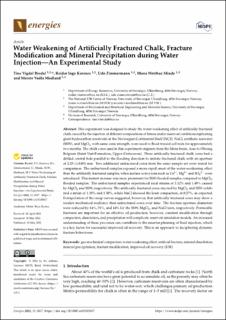| dc.contributor.author | Bredal, Tine Vigdel | |
| dc.contributor.author | Korsnes, Reidar Inge | |
| dc.contributor.author | Zimmermann, Udo | |
| dc.contributor.author | Minde, Mona Wetrhus | |
| dc.contributor.author | Madland, Merete Vadla | |
| dc.date.accessioned | 2022-06-29T18:55:12Z | |
| dc.date.available | 2022-06-29T18:55:12Z | |
| dc.date.created | 2022-06-04T10:09:29Z | |
| dc.date.issued | 2022-05 | |
| dc.identifier.citation | Bredal, T. V., Korsnes, R. I., Zimmermann, U., Minde, M. W., & Madland, M. V. (2022). Water Weakening of Artificially Fractured Chalk, Fracture Modification and Mineral Precipitation during Water Injection—An Experimental Study. Energies, 15(10), 3817. | en_US |
| dc.identifier.issn | 1996-1073 | |
| dc.identifier.uri | https://hdl.handle.net/11250/3001625 | |
| dc.description.abstract | This experiment was designed to study the water-weakening effect of artificially fractured chalk caused by the injection of different compositions of brines under reservoir conditions replicating giant hydrocarbon reservoirs at the Norwegian Continental Shelf (NCS). NaCl, synthetic seawater (SSW), and MgCl2, with same ionic strength, were used to flood triaxial cell tests for approximately two months. The chalk cores used in this experiment originate from the Mons basin, close to Obourg, Belgium (Saint Vast Formation, Upper Cretaceous). Three artificially fractured chalk cores had a drilled central hole parallel to the flooding direction to imitate fractured chalk with an aperture of 2.25 (±0.05) mm. Two additional unfractured cores from the same sample set were tested for comparison. The unfractured samples exposed a more rapid onset of the water-weakening effect than the artificially fractured samples, when surface active ions such as Ca2+, Mg2+ and SO42− were introduced. This instant increase was more prominent for SSW-flooded samples compared to MgCl2-flooded samples. The unfractured samples experienced axial strains of 1.12% and 1.49% caused by MgCl2 and SSW, respectively. The artificially fractured cores injected by MgCl2 and SSW exhibited a strain of 1.35% and 1.50%, while NaCl showed the least compaction, at 0.27%, as expected. Extrapolation of the creep curves suggested, however, that artificially fractured cores may show a weaker mechanical resilience than unfractured cores over time. The fracture aperture diameters were reduced by 84%, 76%, and 44% for the SSW, MgCl2, and NaCl tests, respectively. Permeable fractures are important for an effective oil production; however, constant modification through compaction, dissolution, and precipitation will complicate reservoir simulation models. An increased understanding of these processes can contribute to the smarter planning of fluid injection, which is a key factor for successful improved oil recovery. This is an approach to deciphering dynamic fracture behaviours. | en_US |
| dc.language.iso | eng | en_US |
| dc.publisher | MDPI | en_US |
| dc.rights | Navngivelse 4.0 Internasjonal | * |
| dc.rights.uri | http://creativecommons.org/licenses/by/4.0/deed.no | * |
| dc.subject | IOR | en_US |
| dc.subject | chalk | en_US |
| dc.subject | Improved Oil Recovery | en_US |
| dc.title | Water Weakening of Artificially Fractured Chalk, Fracture Modification and Mineral Precipitation during Water Injection—An Experimental Study | en_US |
| dc.type | Peer reviewed | en_US |
| dc.type | Journal article | en_US |
| dc.description.version | publishedVersion | en_US |
| dc.rights.holder | © 2022 by the authors | en_US |
| dc.subject.nsi | VDP::Teknologi: 500::Berg‑ og petroleumsfag: 510 | en_US |
| dc.source.volume | 15 | en_US |
| dc.source.journal | Energies | en_US |
| dc.source.issue | 10 | en_US |
| dc.identifier.doi | 10.3390/en15103817 | |
| dc.identifier.cristin | 2029484 | |
| dc.source.articlenumber | 3817 | en_US |
| cristin.ispublished | true | |
| cristin.fulltext | original | |
| cristin.qualitycode | 1 | |

